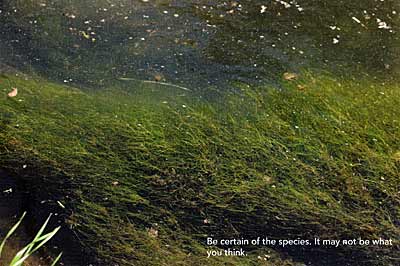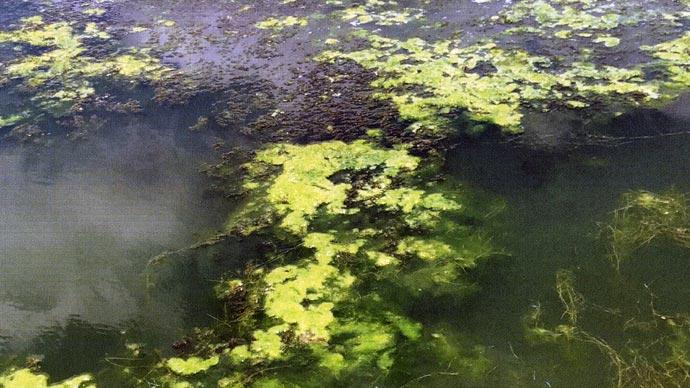
When it's steamy hot and your pond is showing its ability to grow things fast, it doesn't take long for evaporation and lower water levels to combine with fast-growing invasive amounts of aquatic plants. This combination manifests itself into an ugly labyrinth of green confusion all the way from the bottom up to the surface.
It wasn't long ago your plants looked orderly, a nice garden of perfect habitat for baby fish and edge cover to entice a nice bass to the business end of your fishing pole.
If you attempt to fish it now, all you get is a tangled mess of stringy, green goo and grass that almost makes you want to cut your line.
What to do?
Last issue, we took you through a primer about identifying plants, quantifying the amount, analyzing your options, and then making a plan.
Here we are now, in the dog days of summer, and things are out of hand. You need some facts to understand the consequences of what you might, or might not, do.
First, figure out how much of the pond is actually affected by plants. A standard rule of thumb is to estimate how much of the pond is covered. If your plant problem is mostly rooted macrophytes or other submersed plants like coontail, calculate the percentage of your pond that is covered. If it grows on the bottom, but hasn't made it to the surface, it still counts toward your surface area calculation.
Secondly, make sure you correctly identify the plant species and understand its lifecycle. Say you are looking right now and your pond is about 30% covered with curly-leaf pondweed and you can see some other plants growing in clear, deeper water. Should you treat or take other action? This time of year, curly-leaf pondweed tends to abate growth and subside. There is likely no reason to treat it. But, say that mass is coontail buried in mats of Eurasian watermilfoil. What to do there?
When you know the species and how it lives, and then calculate the volume and area of water it consumes, you can make good choices what to do about it.
Let's just stay with coverage for a minute. If a pond is covered 20% or less, that's considered healthy. That doesn't mean it's not invasive, though. If that 20% completely surrounds your dock and covers your swimming beach, that's invasive. You want it to go away. But, if that 20% is a band that surrounds the pond and maybe covers a
shallow cove, that's healthy for the fishery and probably helps with water clarity for this time of year.

As that volume increases from 20% upwards of 40%, it's truly becoming invasive and inhibits your ability to enjoy the pond. If it gets much beyond 50% coverage it affects the fishery. Forage fish can stay hidden and avoid being eaten as your game fish are forced to the sidelines with no ticket to the well-stocked buffet table deep in your underwater salad bar. Once coverage exceeds 50%, into the 60-80% range, now you have imminent problems with the health of the entire pond. Your fishery is jeopardized because those massive amounts of plants are producing too much oxygen during the daytime and using too much at night. The stage is set for a few cloudy summer days and a lethal oxygen depletion.
The Catch-22 of this scenario is if you decide to treat such a mass of plants, you better know what the heck you are doing, or you'll kill too many plants and take your fish out as well.
Judge the volume of plants and do it accurately. Couple that with knowledge of the species and how those plants live, and then make your game plan.
You have choices. Each of those choices has consequences.
If the mass is truly within acceptable ranges, tolerate it and allow nature to do what nature does. If you have areas that are problematic, then choose whether to treat with herbicides or hire some young, strong people to rake it out and pile it up for compost. If you choose to treat with herbicides, strictly follow the label and understand when those plants die, they'll soon release their nutrients, which has consequences. Eurasian watermilfoil, for example, when treated in a local area, tend to quickly breakdown and lend to a plankton bloom, where other areas of milfoil, in deeper water, can be deprived of sunlight, and die, releasing its nutrients. I've seen entire lakes of this plant go away after 10% of the lake was properly treated. Do that in the hottest part of the summer and don't be surprised to see a significant algae bloom that shifts into blue-green algae, exactly when you don't need it.
This time of year, if you don't have triploid grass carp, don't expect to be able to buy them. Producers, haulers, and biologists are queasy about transporting that fish during hot months.
If you decide to pursue treatment with approved herbicides, seek seasoned advice from those who have done it. Consider the services of a pro. Those folks know what to do, and can be held accountable if things go south.
Then, scold yourself for not watching and studying plant growth during the spring months—the time of year best suited to nip it before it gets so bad.
After all, those plants are doing what plants do, and they do their jobs quite well.
Reprinted with permission from Pond Boss Magazine



